Mexican State Capitols: Mexicali, Baja California Norte

The state capitol building in Mexicali. Baja California Norte became a state in 1952.
Visited: August 18-19, 2018
As a state Baja California Norte is a relatively new state, having been admitted in 1959. Before that it was known as a territory. The first traces of humans date back as far as 11,000 years ago. Europeans first came to the area in 1539. It was Jesuit priests who came to the area for the purpose of establishing Catholic missions that brought about significant developments to the area. There are some very densely populated areas of Baja California Norte, but the majority of the state still looks like a territory, this is because the majority of the state is part of

An inside view of our hotel room.
what is known as the Sonoran desert.
In our never ending quest to visit state capitols we found ourselves with some extra time and about $100 budget, so we decided to visit Mexicali the capitol of Baja California Norte. $100 dollars doesn’t seem like much for a two day visit but it is amazing what you can do for that much money.
The first thing you need to do is find a place to stay. Like every city in the world this can be a big variable. If you want, you can find a 5 star hotel with a pool and fancy restaurants, in Mexicali this will set you back about $80 a night. We don’t mind so much about those things and weren’t really interested in going swimming so scaled it back to a two star hotel. For $38 a night we got the Hotel Azteca De Oro. A simple hotel, beds functional, a block from the main street and shopping, weak wifi, cable TV, and included breakfast (2 meals per room).
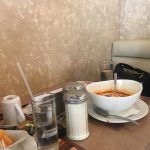
Huevos Ahogados, a new CalMex dish born in Mexicali.

Chilaquiles is a traditional Mexican breakfast.
Speaking of the free breakfast I have a funny story…So I went out on a walk in the morning and told my family to meet me at the restaurant. I was 15 minutes late and I asked my mom if she needed help ordering. She told me “no, the waiter knows what I want.” OK, I thought, made my order and ten minutes later the food came out. The food come and my mom says “this is not what I ordered”. I ask “what did you order?” “Eggs with avocado”, she replies. I ask the waiter, “What she order?” “Huevos Ahogados.” (drowned eggs). Spanish lesson for the day, avocado sounds a lot like ahogado (drowned) in Spanish. they basically were eggs drowned in tomato salsa. Almost like a soup. Denise tried the Huevos Ahogados, she said she liked them, I really don’t like tomatoes so I avoid them. So the chef asked me if egg soup is a thing in the USA, I explained it was not, but maybe we just discovered a new CalMex dish.

All this food was supposedly for two people.
For things to do Mexicali can be a bit of a challenge. In the 20s Mexicali gained a reputation for being a safe haven from the Prohibition and to a certain extent it still is as there are some night clubs and bars in the Centro Historico (historical center), but for the most part Mexicali is just a urban city. Which is funny because just over the border the USA side is very agricultural, which makes the different very contrasting. That said Mexicali that caters for tourists. It is just a city doing it’s thing and seems to be OK without the gringos messing it up. Which is nice, because like other Mexican cities I have been to there was no begging and heavy selling, not to say there isn’t people selling things, it just isn’t aggressive. You can go to park, restaurant, etc. and just sit and enjoy life go by with everyone else. That said it was a challenge to find “things to do” but we did find two different things. El Museo Del Sol (the Museum of the Sun) and el Bosque de la Cuidad (the City Forest).

A map showing the park facilities.
The first place we went to visit was el Bosque de la Cuidad. This is a city park/zoo/aviary/water park. The cost for admission was $15 pesos (about .75 cents) for parking and $20 pesos (about a dollar) for tickets. The name Bosque de la Cuidad means “City Forest” and it lives up to the name as the venue is quite big. The first part of the park is a playground and aviary where there are literally hundreds of different types of birds. There is also an indoor aviary you can walk through that AJ and I called “Poop Village”, it was clean but be warned hundreds of birds flying over you, stuff happens. To the back of the park is a little zoo complete with lions, tigers, and jaguars. Hey it’s Mexico, but if it makes you feel better they have bears too. There is a giant lake in which the locals try their luck at catching catfish to eat for their picnics with families. After walking around the park I quickly realized I hadn’t gotten any where close to seeing all the park but they had a little train that circled the park for $25 pesos (about $1.20 USD). The park is REALLY big, if you go take the train, you’ll see what I mean.

My mom in front of the IMAX theater, the IMAX theater is basically a really big screen movie theater that makes you feel like you are in the movie.
Mexicali is hot, when we were there the high of the day was 110 degrees (43 C). After walking around the city park in the heat we were starting to melt and needed a place to escape. So in a kind of ironic move we went to El Museo del Sol, the “Museum of the Sun”. Despite the hot name, the museum was indoor and had air conditioning, which was just what we needed. The Museo del Sol is a children’s museum and is filled with a bunch of different hands on science experiments. It also has a IMAX theater where we saw a presentation on the National Parks. It was fun film but it was kind of funny being in Mexico watching a video extolling the virtues of the National Parks system. Cost for the museum and the show is $5 but talking to the ticket guy he told me of a family package that costs $325 pesos (about $17) and was good for 4 people.
After the museum we needed to head back to the USA but we were hungry. Luckily in Mexico that is never a problem. Mexico is a poor country, people live in really poor conditions, but hunger is not one of those conditions. When it comes to food in Mexicali, things get a little different. When one thinks Mexican food, one thinks tortillas, beans, and rice. Mexicali does have those things but they are not quite prepared the way you would expect them. Mexicali in the early 1900s saw a lot of Chinese immigrants. The Chinese came to to the Americas to build the railways system, but the United States went through one of it’s many waves of anti-immigration and many Chinese people decided to go to Mexico. The largest congregation of Chinese immigrants in Mexico is in Mexicali. Due to that fact there are a lot of establishments that cater to Chinese tastes, the foremost being Chinese restaurants. Mexican Chinese food is a an awesome experience. I like Chinese food, but mix Asian and Mexican spices and you get a mix your mouth will never forget. Two dishes that exemplify this was the Chinese medley and the chipotle Shrimp. The Chinese medley was like a Chinese vegetable dish but in addition to things like snow peas it had other vegetables like corn and squash. The chipotle Shrimp was like sweet and sour shrimp gut the spicy start had a taste of deep smoked chilies. Warning, the serving sizes are huge. We got there and they had these combo plates that were priced per person. We had four in our party so I ordered four portions. The waiter quickly shut that down, he told me he was going to just order us two. I thought that was strange, the price per portion was $200 pesos (about $10 USD), I let him know that we had enough money, he said to trust him so we did. He was right, I am so glad we only ordered for two, I can’t even think of what it would have been like if we had ordered for 4 people.
Traveling back to the USA it is important to note that there are two border crossings in Mexicali, East and West. Both crossings have Sentri and standard crossing, but only the East crossing has ReadyLane. If you have a passport card go to the East crossing, it is a lot faster than going through the standard crossing. My only other advise is other than answering questions please do not talk to the border crossing officials. Even if you take an extra 30 seconds, that is going to get compounded into the line and delay everyone else waiting. In our case the heat and idling was a bit too much for the car we were driving. We got across the border OK but had to stop at the gas station directly across the border because the coolant was overheating.

If your in Mexico and don’t know where to go but need some decent Mexican food, go to a Sanborns.

My mom got the signature dish, enchiladas suizas. Denise got tostadas ligeras. I think this time the tostadas won.
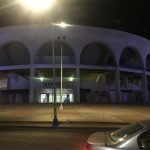
The Mexicali bullring.
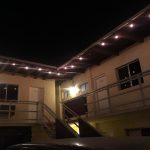
An outside view of our hotel room.

An inside view of our hotel room.
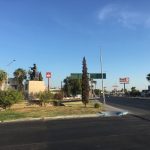
The start of Paseo de los Heroes. Where many Mexican heroes are honored.

Josefa Dominguez was a Mexican insurgent who fought for Mexican Independence.

The obelisk is dedicated to the conquistadors who came to Mexicali in about 1536.

The state capitol building in Mexicali. Baja California Norte became a state in 1952.

AJ ready for his free French toast breakfast.

Chilaquiles is a traditional Mexican breakfast.

Huevos Ahogados, a new CalMex dish born in Mexicali.

Mexicali is a pretty city, but there is poverty.

The entrance to the Bosque de la Cuidad.

One of the many peacocks roaming the park.

A map showing the park facilities.
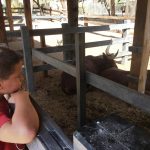
AJ checking out some long horn steers.
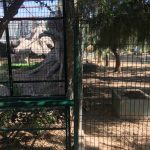
I found it hilarious that the lion cage was right next to the caribou cage.

The hyena was very interested in AJ.

The sign says “Hasta La Proxima Sobrevivientes” (Till next time survivors). Which was interesting considering the condition of the bridge.

The walk through aviary AJ and I named Bird Poop Village.
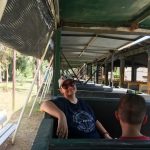
The train operators were very nice to us to let us ride even though there were not many riders.

This picture helps show how big the park was. The lake is on the other side of the park.

The entrance to the Museo del Sol.

AJ climbing on of the many hands on exhibits.

AJ reenacts his version of Han in carbonite.

Denise demonstrates a bed of nails.

My mom in front of the IMAX theater, the IMAX theater is basically a really big screen movie theater that makes you feel like you are in the movie.

The Pekin Restaurant was a different environment being in Mexico.

All this food was supposedly for two people.

The chipotle shrimp embodies the cross of Mexican and Chinese cuisine.

The signs heading back into the USA can be confusing, make sure you have a good map.


Comments
Mexican State Capitols: Mexicali, Baja California Norte — No Comments
HTML tags allowed in your comment: <a href="" title=""> <abbr title=""> <acronym title=""> <b> <blockquote cite=""> <cite> <code> <del datetime=""> <em> <i> <q cite=""> <s> <strike> <strong>